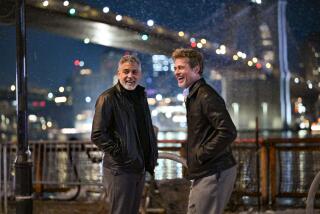‘The Monuments Men’ filmmakers faced monumental challenges
George Clooney and Grant Heslov describe themselves as two of the least cynical people in Hollywood. But when the longtime collaborators looked back at their recent work, they realized the movies had an unshakable gloom: “The Ides of March,” “Good Night, and Good Luck,” “The American” and “August: Osage County” were hardly films that made you feel better about the world.
So Clooney and Heslov decided to change course and put together a crowd-pleasing tale. The resulting work, Friday’s “The Monuments Men,” is a curious departure for the filmmakers — a sometimes lighthearted account of a largely untold chapter of World War II history that recalls some of the less serious movies about the conflict.
“We set out from the very beginning to do our version of ‘Kelly’s Heroes’ and ‘The Great Escape,’” Clooney said of the 1970 and 1963 World War II movies that are more similar in style to the all-star disaster movie “The Towering Inferno” than the Holocaust drama “The Pianist.”
Loosely adapted from Robert Edsel’s book “The Monuments Men: Allied Heroes, Nazi Thieves, and the Greatest Treasure Hunt in History,” the movie is directed and stars Clooney, who co-wrote the script with Heslov, his fellow producer on the movie (Heslov also has a cameo as a field surgeon). A co-production of Sony Pictures and 20th Century Fox, “The Monuments Men” originally was set to be released in December but had to be postponed because Clooney was unable to complete the film’s visual effects.
“It’s a big movie and we just physically couldn’t finish it,” Clooney said. “A movie like this can’t have modern-looking effects in it.”
Early reviews for the $70-million “Monuments Men” have been mixed and projections for opening weekend box office have it in the $20-million range, where it will badly trail “The Lego Movie.” But Clooney says the movie would have been crushed had it been released as originally planned on Dec. 18.
“It was a bloodbath over Christmas,” he said. “I’m thrilled where we are.”
The Monuments Men were a largely American amalgam of more than 300 curators and academics who went to Europe on the heels of the Normandy invasion in 1944 to preserve architecturally significant buildings and repatriate artwork looted by the Nazis, a good deal of which was destined for Hitler’s planned Führermuseum in the Austrian city of Linz.
PHOTOS: Billion-dollar movie club
The Germans looted millions of paintings and statues, mostly from France and Belgium, before and during the war and destroyed countless paintings by artists like Picasso that they considered degenerate. As the war wound down, their plunder was then targeted by the Russians, who wanted to keep it for themselves.
The reverse-heist story had two points of obvious appeal to Clooney and Heslov. First, its fish-out-of-water setting, where well-educated men more at home with manuscripts and canvases were handed rifles and thrown onto the battlefield, and second, a chance to cast an ensemble populated with some of Clooney and Heslov’s all-star friends and colleagues.
Clooney plays Frank Stokes, (the names of the real Monuments Men have been changed in the film), whose art recovery team includes Bill Murray, Matt Damon, John Goodman, Bob Balaban, Jean Dujardin from “The Artist” and Hugh Bonneville from “Downton Abbey.” Cate Blanchett plays a member of the French resistance who knows where Hitler has hidden much of the purloined masterpieces, which included works by Cezanne, Renoir and Michelangelo.
In adapting Edsel’s thoroughly reported book, Clooney and Heslov faced several challenges, including manufacturing realistic copies of some of the masterpieces at the center of the tale. The more critical test was winnowing the sprawling book down to a core group of people and a handful of missing artworks, and finding a consistent tenor for the entire film.
Oscars 2014: Complete list of nominees | Play-at-home ballot
“We knew we wanted it to be a lighter tone, always,” Clooney said. “Anybody who read the screenplay knew it wasn’t going to be ‘Saving Private Ryan.’” The earliest cuts of the film (much like the first trailers promoting its release) were jokier than the final version, even as the finished film still ricochets from slapstick to tragedy.
“We overwrote the lighter stuff,” Clooney said. “The script is much, much lighter than the actual tone of the film. There were some really funny scenes that are not in the movie. Because you can be light at the start, but not at the end, once people start dying.”
The production, which filmed in Germany and England, struggled to replicate the artwork that the Monuments Men were pursuing. Sony, which produced “The Da Vinci Code,” lent the movie several hundred paintings from that movie, and Clooney and Heslov hired one sculptor to try to re-create Michelangelo’s 16th century Madonna of Bruges.
After three months of effort, the sculptor showed the filmmakers his reproduction. “You know it’s close. But it’s not quite it,” Clooney told the artist. “And the sculptor goes, ‘You know, I’m not quite Michelangelo.’” When the movie’s release date was pushed back, the film’s visual effects team had time to place via computer the face of the real sculpture onto the duplicate, thus approximating the original’s countenance.
PHOTOS: Box office top 10 of 2013
While “The Monuments Men” is clearly a period film, its makers hope its lessons have modern relevance. Indeed, some art looted by the Nazis has surfaced in recent months, including November’s discovery in a Munich, Germany, apartment of more than 1,000 works. In all, an estimated 5 million pieces were returned to their countries and owners, but as many as 1 million remain missing.
“It’s important to remember that it was the first time that a country gave back the spoils of war,” Clooney said. “We’ve seen what happens when you don’t protect art — what happened in Iraq and what’s happening in Syria — and how badly that can affect a society.”
Clooney said that were the Mona Lisa inside a burning building, he, like most people, would be unwilling to risk dying to save it. “But the idea that somebody would try to steal your culture away?” he said. “That’s absolutely worth giving your life for.”
More to Read
Only good movies
Get the Indie Focus newsletter, Mark Olsen's weekly guide to the world of cinema.
You may occasionally receive promotional content from the Los Angeles Times.











